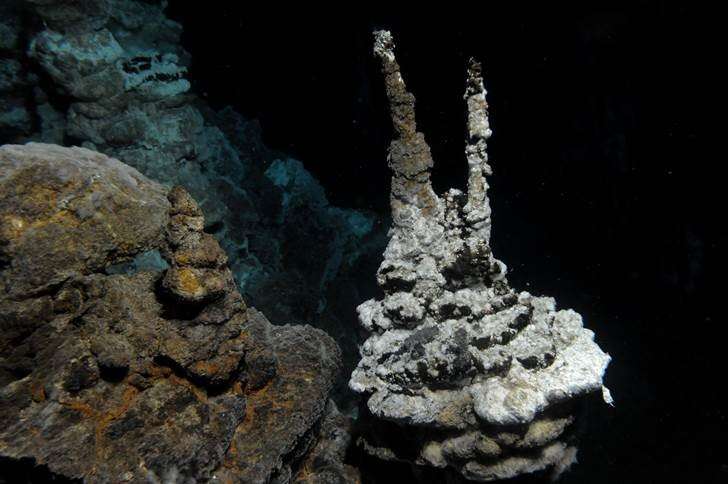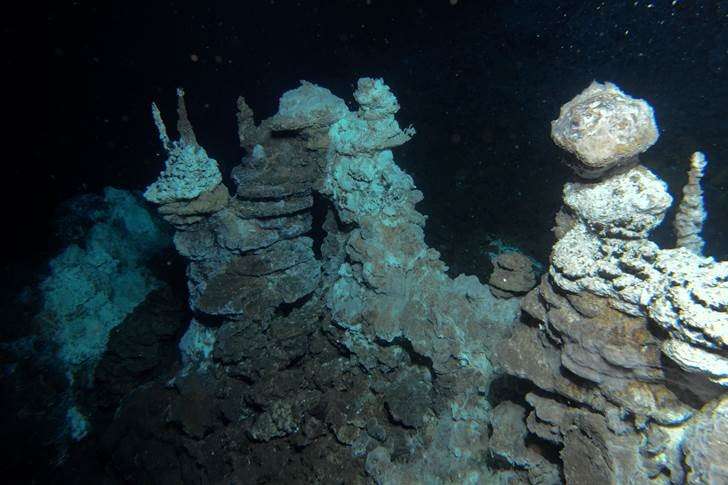Origin of Complex Life
 Complex life – from humans to hamsters--may have evolved suddenly from a rare event. After two billion years of simple bacterial and archaeal life reigning on earth, an archaea may have swallowed a bacterium, and become a new creature with enough energy to grow and diversity like never before: the eukaryote.
Complex life – from humans to hamsters--may have evolved suddenly from a rare event. After two billion years of simple bacterial and archaeal life reigning on earth, an archaea may have swallowed a bacterium, and become a new creature with enough energy to grow and diversity like never before: the eukaryote.
A new Nature study this week may have provided the strongest evidence yet of this in its description of a new archaeon – found near an arctic hydrothermal vent - with genetic properties of both archaea and eukarya.
“The most surprising moment was when we were a couple of weeks into the project and were looking at the first datasets that we retrieved from the sequencing center,” senior author Uppsala University microbiologist Thijs Ettema told Bioscience Technology. “We started finding all these 'eukaryotic-type' genes among these archaeal sequences. We very soon realized that this was either a very big and significant find, or some kind of weird artefact. After doing a whole array of checks in order to make sure that we could rule out the latter, we were sure: we found an archaeon that shared several genes uniquely with eukaryotes. When later this archaeon, which we then named Lokiarchaeon, turned out to form a sistergroup with eukaryotes in the Tree of Life, we were ecstatic!”
National Institutes of Health Senior Investigator Eugene Koonin, uninvolved in the work, told Bioscience Technology the paper is “of great importance.”
Agreed New Castle University microbiologist Martin Embley: “It’s an important breakthrough.” Embley, also uninvolved in the work, noted to Bioscience Technology that, “it identifies the closest prokaryotic relative of eukaryotes, and strongly supports hypotheses that claim that essential components of eukaryotic cells were inherited from an archaeal ancestor—in other words, that we have an archaeal parent. As such it provides strong evidence that the classic three domains tree is inaccurate for the relationship of Eukaryotes to Archaea.”
Remaking the tree of life
Until recent years, it has been believed that life at base is comprised of three distinct branches, all of which hailed, individually, from an unknown single ancestor: arachael and bacterial cells, simple cells that lacked nuclei, and complex eukaryotic cells containing nuclei, cytoskeletons, organelles. That three-tree system was proposed by University of Illinois microbiologist Carl Woese, who added a third branch—the archaeal branch—to the tree in 1977.
 But at about the same time, a 1967 paper by University of Massachusetts biologist Lynn Margulis began catching on. That unusual paper proposed that humans’ mitochondria, the critical energy packs of our cells, are actually bacteria that were once engulfed by other cells. Genetic analyses backing this up, in addition to other genetic data finding similarities between the life branches, led to doubt the three branches rose independently of each other.
But at about the same time, a 1967 paper by University of Massachusetts biologist Lynn Margulis began catching on. That unusual paper proposed that humans’ mitochondria, the critical energy packs of our cells, are actually bacteria that were once engulfed by other cells. Genetic analyses backing this up, in addition to other genetic data finding similarities between the life branches, led to doubt the three branches rose independently of each other.
The Uppsala team’s new discovery of Lokiarchaea, which possesses many unique eukaryotic and archaeal qualities, offers what Embley called in a companion commentary “spectacular” evidence that the above independent evolution may indeed not have occurred.
Instead, chaotic, complex eukaryotes like us may have emerged out of a two-billion-year old sea of serene, simple life forms due to the unusual engulfing of a bacteria by an archaea, forming a creature rife with new possibilities.
The new paper
The new paper identifies “archaeal forms that are much more closely related to the hypothetical archaeal ancestor of eukaryotes than any other currently known group of archaea,” Koonin told Bioscience Technology. “These findings clinch the case for the origin of eukaryotes from within the archaeal diversity, and point to specific part of the archaeal evolutionary tree where eukaryotes belong.”
Equally importantly, Koonin continued, are the group’s findings that, “Lokiarchaeota combine a number of ‘eukaryotic-like’ features that previously have been found scattered among different archaeal genomes. In particular, they encode components of the actin cytoskeleton, the ESCRT-III system for membrane remodeling, and the ubiquitin system. Taken together, these findings give credence to the evolutionary scenario in which the eukaryotes evolved from an archaeon with a complex cellular organization that might have been capable of engulfing bacteria.”
Embley told Bioscience Technology that, in terms of clarifying the origins of our mitochondria, “the new Archaea appear to have the potential for endocytosis and/or phagocytosis (cellular incorporation and/or ingestion). This could allow them to take up material from the environment. In some versions of endosymbiotic theory, the host for the mitochondrial endosymbiont uses phagocytosis to engulf the bacterium that became the endosymbiont, and eventually the mitochondrion.”
On the other hand, he noted: “There is no genetic evidence in the new paper that the new Archaea contain any genes from the mitochondrial endosymbiont, so they do not appear to have mitochondria.” But the newly discovered creature’s actin-like proteins may simply indicate, he said, that eukaryotes evolved phagocytosis before acquiring mitochondria.
Did the team prove we are descended from Lokiarchaea-like creatures? “I think that the phylogenetic analyses are carefully done and use state-of-the-art methods,” Embley said. “It is really hard to correctly infer events that may have occurred some two billion years ago. But taken together, the combination of the tree, and the enhanced number of eukaryotic-like proteins, are rather convincing for a close relationship between Lokiarchaea and eukaryotes. I am sure that the new data and analyses will be subjected to very close scrutiny by the community once it is published, and the robustness of the trees and the position of eukaryotes within them, will be carefully tested as part of that process.”
More details on how life evolved
Ettema told Bioscience Technology that his team’s next steps will be “to somehow obtain an image of Loki cells.” His team used computational methods to analyze composite DNA stretches culled from samples in marine sediment. “Thus far we have been restricted to look at its genome. By looking at Loki's cells, we would be able to see if it resembles eukaryotes a little bit with respect to the eukaryotic gene-types that we have identified.”
In addition, Ettema’s crew is trying to obtain other “Loki-like organisms. With obtaining their genomes, we will be able to get an even more detailed picture of how complex life might have evolved.”





